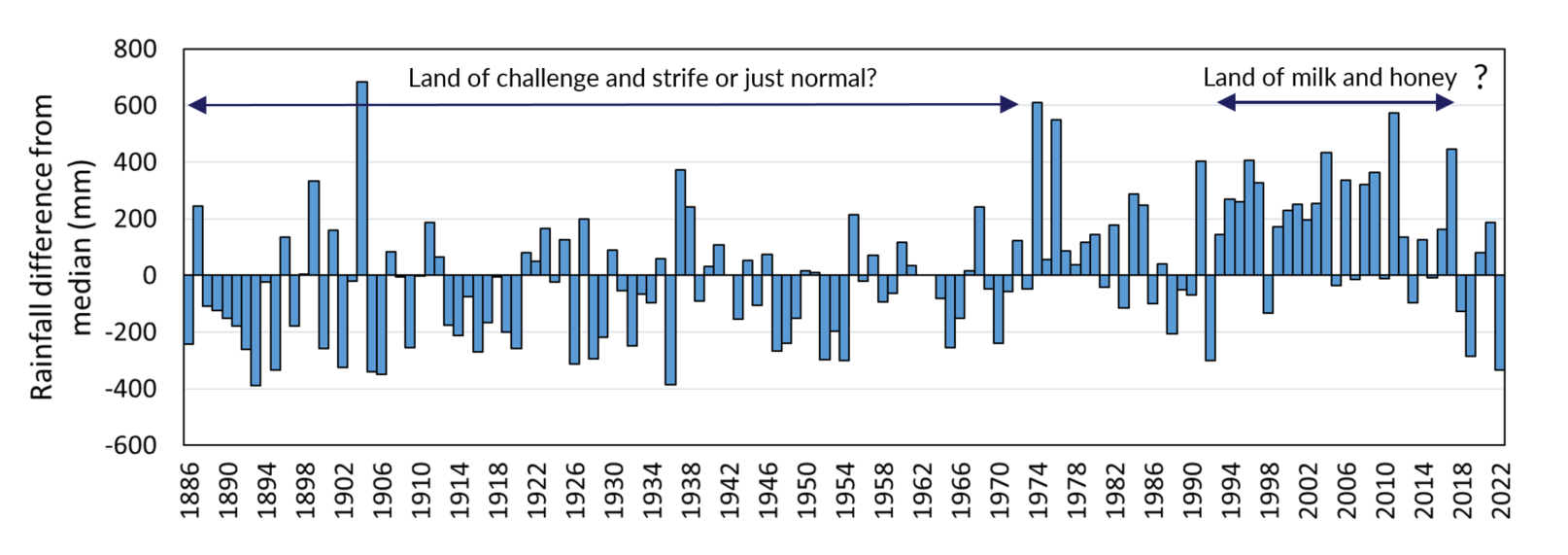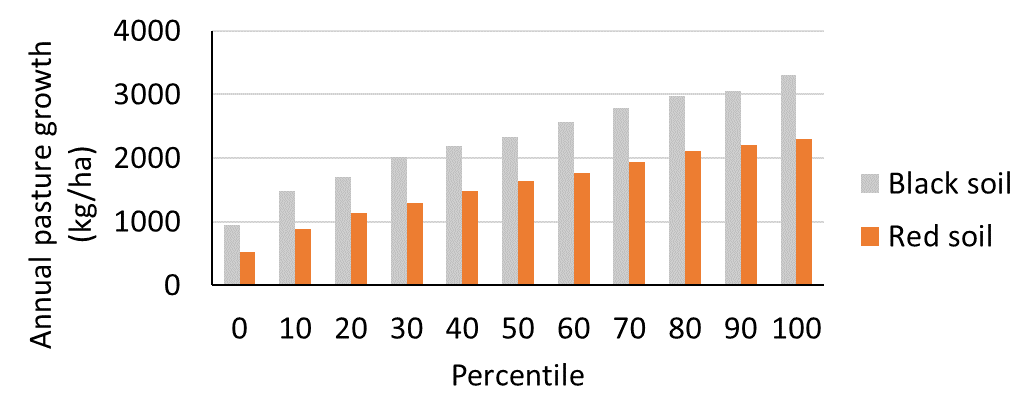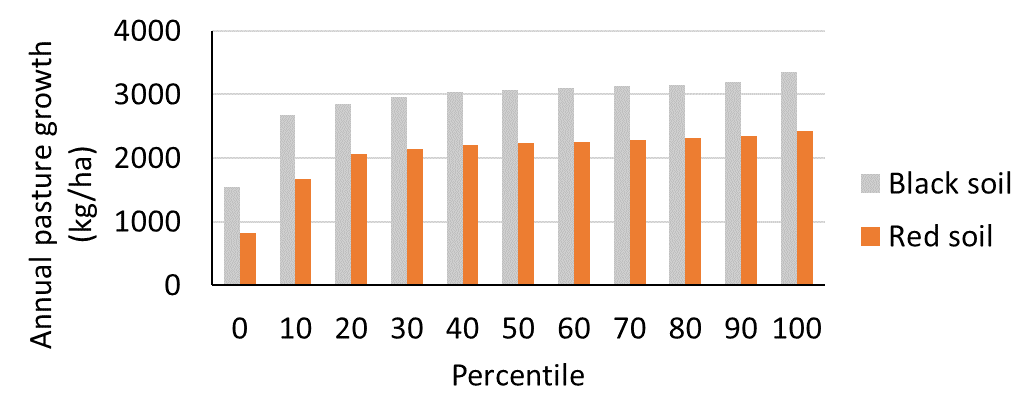What happened to the good years? Understanding and planning for long term variability in pasture production
The 25 year period between 1993 and 2017 is the wettest on record in the Victoria River District. But we don’t know if this is a new normal, or if rainfall has since shifted to a drier phase. Most land managers in the northern NT have not experienced extended drier periods before the last few years, but they have occurred many times since rainfall records began. Extended periods of lower rainfall can last many years or even decades, and can drive long-term shifts in pasture species, pasture growth and safe stocking rates.
The good years
At Victoria River Downs (VRD) there were only 5 years of below median rainfall (647mm) between 1993 and 2017, and of those, 3 were close to median (Figure 1). Any below median year was immediately followed by an above median rainfall year. It was easy to manage climate variability in this part of the world in that quarter century, because it was actually incredibly reliable compared to southern and eastern Australia.

The bad years
In contrast, 3 out of the 5 years following 2017 have had below median rainfall, with 2022 the 5th driest on record. In the 25 years prior to 1993 nearly half the years had below median rainfall, which is what we would normally expect. Going back further, in the first 50 years of rainfall records at VRD from 1886, 7 in 10 years had below median rainfall. We don’t know what the rainfall will be in the future, but the rainfall records give us an insight into the range of possibilities. It can get a lot drier for many decades at a time.
Effect of rainfall on pasture growth and safe stocking rate
But does less rain mean less grass growth and lower safe stocking rates? Pasture growth can vary a lot year to year when rainfall is variable (Figure 2), most especially in areas where median rainfall is less than 700mm. In higher rainfall areas (more than 700mm) pastures often run out of nutrients before they run out of water, and pasture growth is more stable year to year, but can still be lower in very dry years (Figure 2).


When we take into account the safe level of use of pastures by cattle for red (15%) and black (20%) soils, the safe stocking rate also varies. For lower rainfall regions such as VRD, safe stocking rate can be quite variable (Figure 3). However in higher rainfall areas like Timber Creek (Figure 4) (median rainfall 813mm), most years had similar modelled pasture growth, and safe stocking rates varied much less over time (Figure 4).


What happens if it stays drier?
It depends on what your average rainfall is and how stocking rates are managed. In the first 50 years of climate records at VRD, modelled safe stocking rates on a moderate productivity red soil were lower than between 1993 and 2017 (7.5 vs. 10 AE/kmsq). But at Timber Creek, drier years made little difference to pasture growth and safe stocking rates (11 AE/kmsq for both time periods), because there was usually still more rainfall than pastures can use (i.e. pasture growth is limited by soil nutrient availability).
In areas with rainfall similar to, or lower than VRD, if the climate has shifted to a drier phase, the higher safe stocking rates of the past few decades will not be sustainable. Pasture growth in these lower rainfall areas is usually water limited, so less rainfall will lead to lower growth and lower safe stocking rates.
In higher rainfall areas pasture growth is less water limited and lower rainfall may not change pasture growth that much, but there may be more years with lower pasture growth than previously.
What can we do to manage an uncertain rainfall future?
In the quarter century to 2017, stocking rate adjustments were rarely needed because any drier year was followed by an average or above average year. However, when there are multiple consecutive dry years, stocking rate adjustments may be required to look after pastures and livestock welfare. Failure to do so could lead to higher pasture utilisation and subsequent decline in pasture condition, lower rainfall use efficiency and lower pasture production potential of your landscapes. To find out more about the variability in pasture growth and safe stocking rates for different land types and regions contact Caroline Pettit on 08 8999 2014.
What are percentiles?
It’s a way of describing how often something occurs.
| Percentile | How often? |
|---|---|
| 0 | Lowest |
| 10 | Bottom 10% of years |
| 20 | Bottom 20% of years |
| 30 | Bottom 30% of years |
| 40 | Bottom 40% of years |
| 50 | Occurs in half of all years, also known as the median |
| 60 | Top 40% of years |
| 70 | Top 30% of years |
| 80 | Top 20% of years |
| 90 | Top 10% of years |
| 100 | Highest |
Median rainfall occurs in 50% of years. 50% of years are drier than the median, and 50% are wetter than the median.
Average rainfall is the sum of all annual rainfall totals, divided by the number of years of rainfall totals.
For more on percentiles go to Explainer on percentiles
Safe level of use / safe utilisation
Safe utilisation - the proportion of the total annual pasture growth that can be sustainably removed by cattle without damaging land condition.
More productive land types have a higher safe level of use. Improved pastures can sustain higher utilisation than native pastures which are not adapted to high levels of grazing.
| Land type | Utilisation (%) |
|---|---|
| Improved pastures | 30-50 |
| Cracking clays | 20 |
| Moderate productivity red soils | 15 |
| Low productivity red soils | 10 |
| Spinifex | 0-5 |
